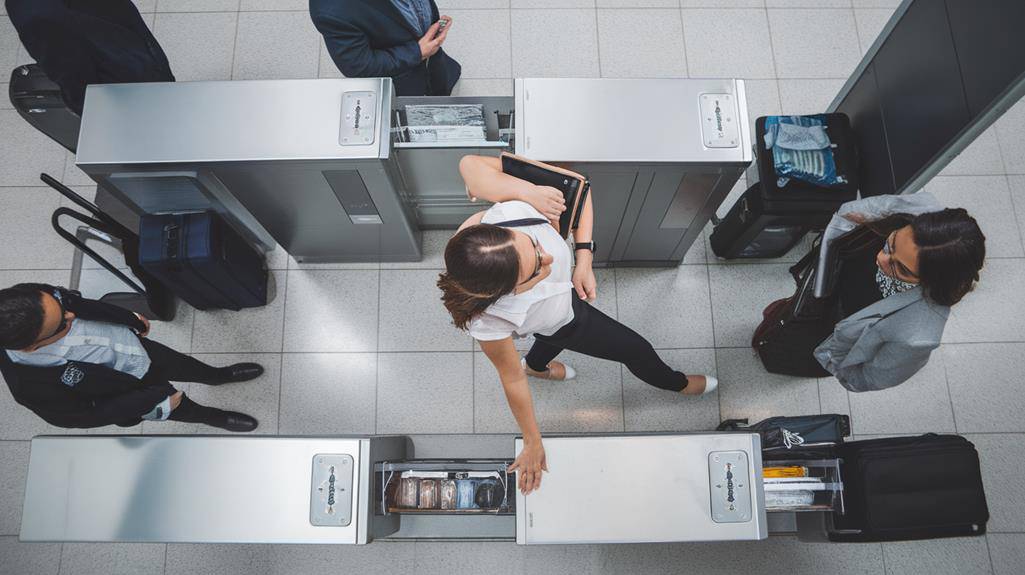
7 Clever Tricks for Breezing Through Airport Security
To breeze through airport security, pack smart by using packing cubes and rolling clothes. Dress efficiently in slip-on shoes and clothing without metal components. Prepare documents in advance, ensuring easy access to your passport and boarding pass. Leverage technology by using airline apps and enrolling in trusted traveler programs. Choose the right security lane by observing passenger flow and opting for less crowded options. Master the conveyor belt dance by removing items while in line and placing them strategically in bins. Finally, stay calm and polite throughout the process, following instructions promptly. These techniques will substantially streamline your airport experience, but there's even more to discover about optimizing your travel efficiency.
In a Nutshell
- Pack smart with a TSA-compliant carry-on and organize items for easy inspection.
- Dress strategically, wearing slip-on shoes and clothing without metal components.
- Prepare documents in advance and use digital options like mobile boarding passes.
- Enroll in trusted traveler programs like TSA PreCheck for expedited screening.
- Master the security line routine by removing required items while waiting.
Pack Smart, Pack Light
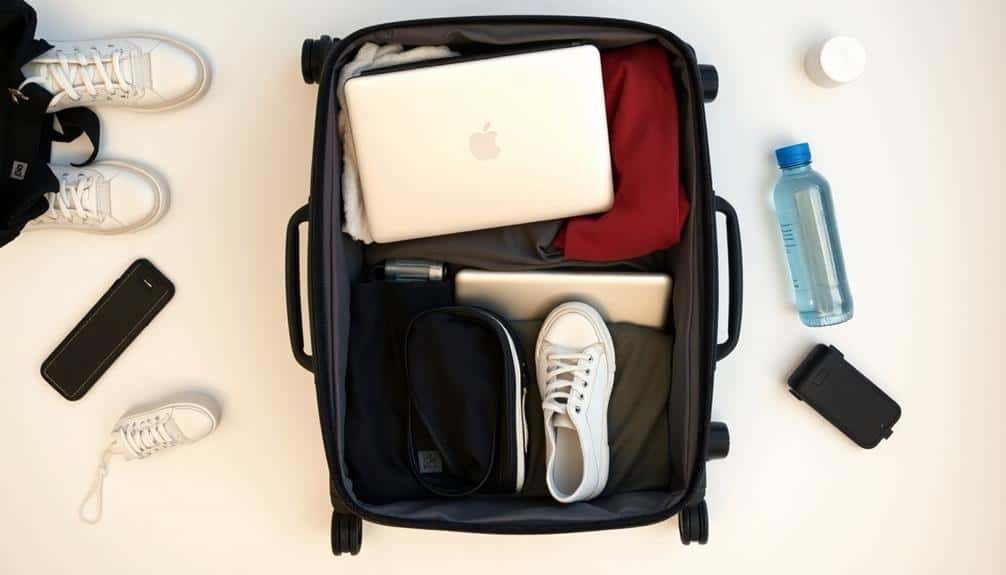
Savvy packing is your ticket to a smoother airport experience. Start by selecting a carry-on bag that meets airline size restrictions, typically 22" x 14" x 9". Opt for a lightweight, durable suitcase with smooth-rolling wheels and multiple compartments. When packing, employ the roll method for clothes to maximize space and minimize wrinkles. Place heavier items at the bottom, near the wheels, for better balance. Organize toiletries in a clear, quart-sized bag for easy removal during screening. Wear your bulkiest items, such as jackets or boots, to save space. Pack electronics in easily accessible outer pockets. Consider using packing cubes to compartmentalize your belongings, making items easier to locate and keeping your bag organized. These versatile organizers come in various sizes and can substantially improve your packing efficiency. Remember to leave prohibited items at home and check your airline's specific regulations before departing.
Dress for Efficiency
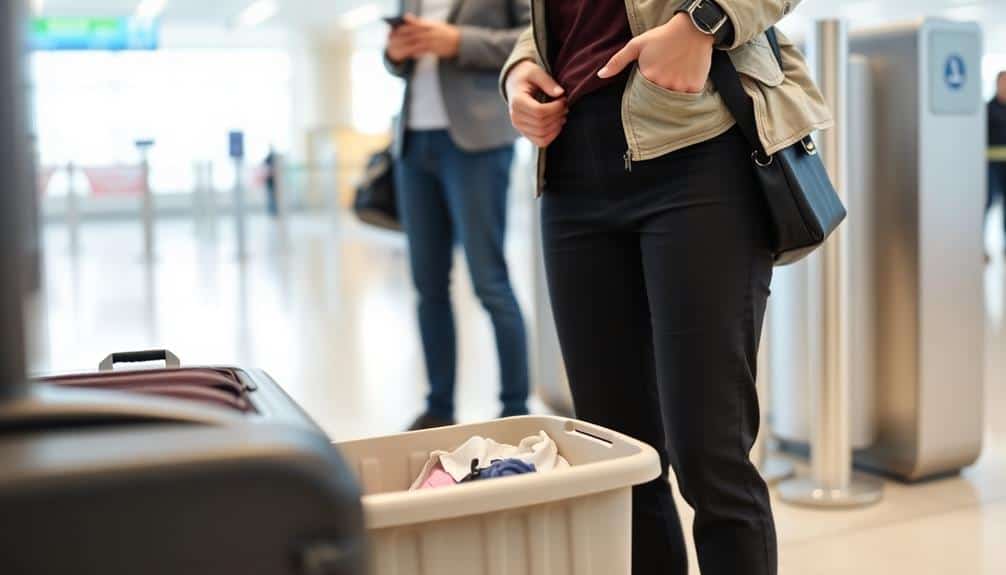
Your attire can substantially impact your airport security experience. Opt for slip-on shoes, avoiding laces or complex fastenings, to expedite removal and replacement. Choose clothing without metal components, such as belts with plastic buckles or pants that stay up without a belt. Wear easily removable outer layers, like zippered jackets or cardigans, to quickly adjust for temperature changes and security checks. Consider wearing socks to protect your feet when shoes are removed. Minimize jewelry and accessories, selecting only essential items that won't trigger metal detectors. For a smoother journey, pack essential travel accessories that complement your efficient airport attire. If you must wear jewelry, choose pieces that are easy to remove and store. For women, sports bras with minimal metal components can reduce the likelihood of additional screening. By strategically selecting your outfit, you'll streamline your passage through security checkpoints, saving time and reducing stress.
Prepare Documents in Advance
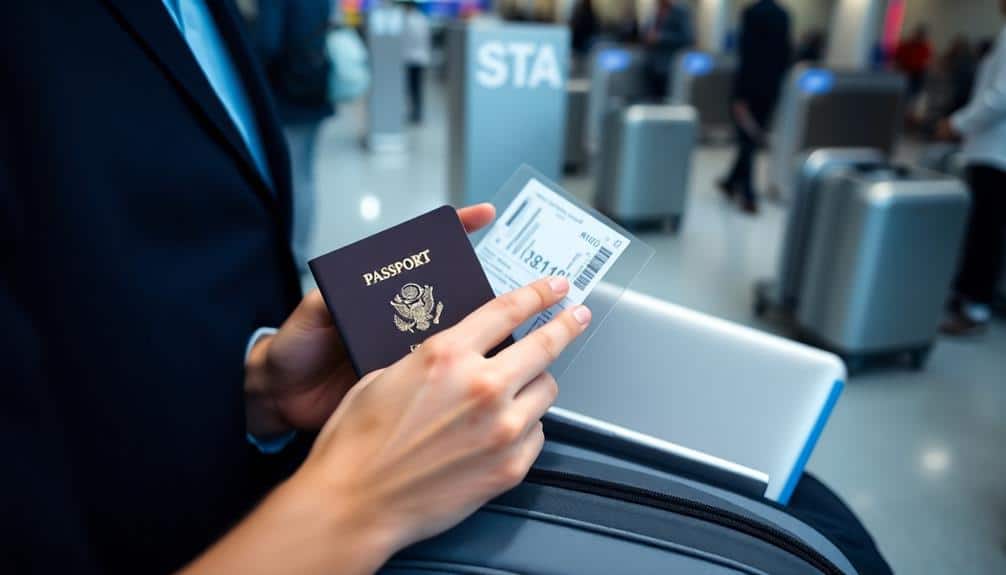
Preparation is key when it comes to breezing through airport security. To streamline your experience, gather all necessary documents well in advance of your travel date. Guarantee your passport, boarding pass, and any required visas are easily accessible, preferably in a dedicated travel wallet or document holder. For international flights, research entry requirements for your destination and have any additional paperwork ready. Don't forget to secure your luggage with appropriate locks to protect your belongings during transit. This added security measure can provide peace of mind throughout your journey.
To further expedite the process:
- Make copies of important documents and store them separately from originals
- Download your airline's mobile app for digital boarding passes
- Pre-fill customs forms if available online
- Keep a printed itinerary with confirmation numbers and contact information
Leverage Technology and Apps
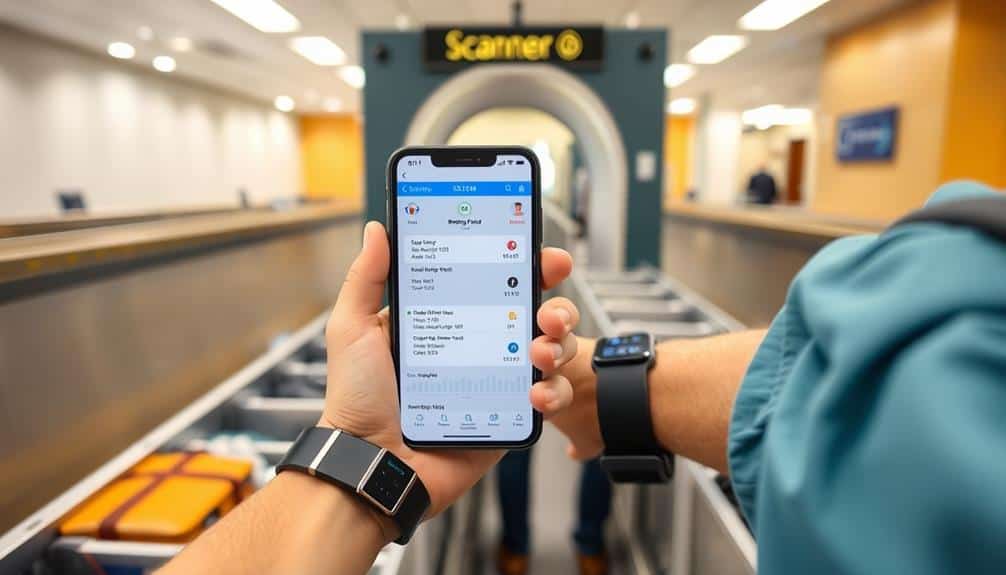
Modern technology offers numerous tools to simplify your airport security experience. Download your airline's mobile app to access digital boarding passes, real-time flight updates, and gate information. Many airports now provide their own apps with interactive maps, security wait times, and even food ordering services. Consider enrolling in trusted traveler programs like TSA PreCheck or Global Entry, which offer expedited screening processes and dedicated lanes. These programs often come with their own smartphone apps for managing memberships and accessing benefits. To streamline your journey further, use apps like Mobile Passport Control for international travel, allowing you to submit customs declarations electronically before arrival. Time-saving technologies like CLEAR, which uses biometric data for identity verification, are increasingly available at major airports. For international travelers, comprehensive language translator devices can be invaluable tools, supporting over 137 languages with impressive accuracy and offline functionality. These devices often feature voice translation, photo translation, and even integrated AI assistants for thorough language support. By leveraging these digital tools, you'll navigate airport security more efficiently and reduce stress during your travels.
Choose the Right Security Lane
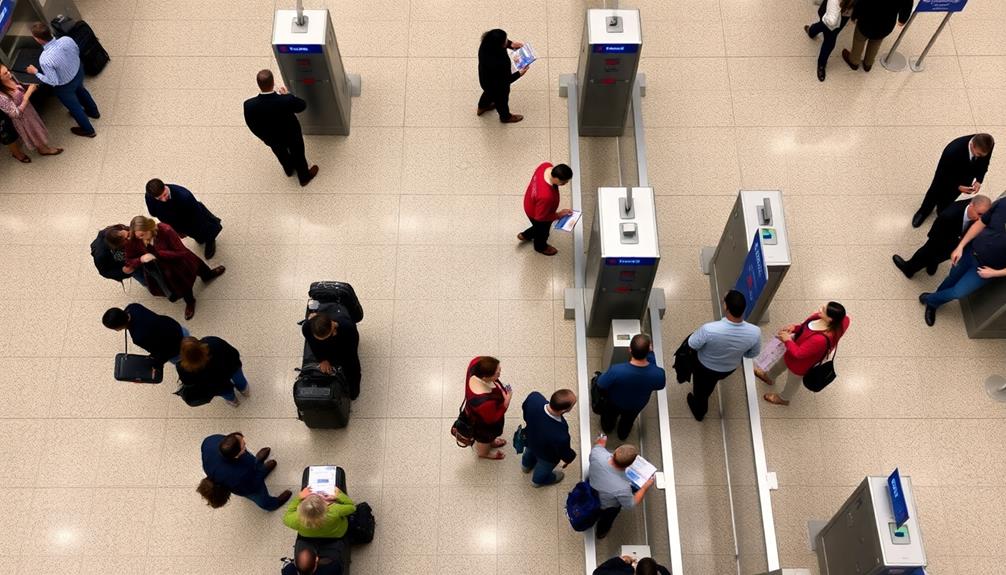
Selecting the appropriate security lane can substantially reduce your wait time and stress at the airport. When faced with multiple options, consider the following factors to make an informed decision:
- Observe the flow of passengers in each lane, opting for the one with the most efficient movement.
- Look for lanes designated for frequent flyers or premium passengers if you qualify, as these often move faster.
- Choose lanes furthest from the main entrance, as they're typically less crowded.
- Consider TSA PreCheck or similar expedited screening programs for a smoother experience.
Master the Conveyor Belt Dance
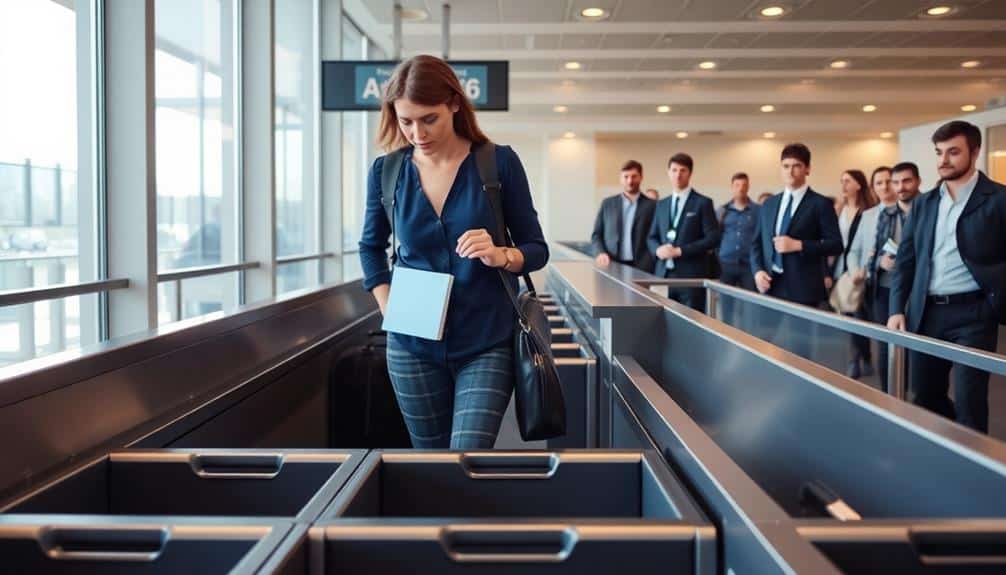
Once you've chosen the ideal security lane, it's time to tackle the conveyor belt process. Begin by removing your shoes, belt, and outerwear while waiting in line. As you approach the belt, have your laptop and liquids bag readily accessible. Place these items in separate bins, followed by your carry-on luggage. Your shoes should go directly on the belt, not in a bin. Remember to empty your pockets completely, placing all metal objects, including keys and coins, in a designated bin. If you're wearing a watch or jewelry, remove these items as well. As you move through the metal detector or body scanner, keep your boarding pass and ID in hand. By organizing your belongings efficiently and following TSA guidelines, you'll streamline your security experience and reduce stress for yourself and fellow travelers.
Stay Calm and Be Polite
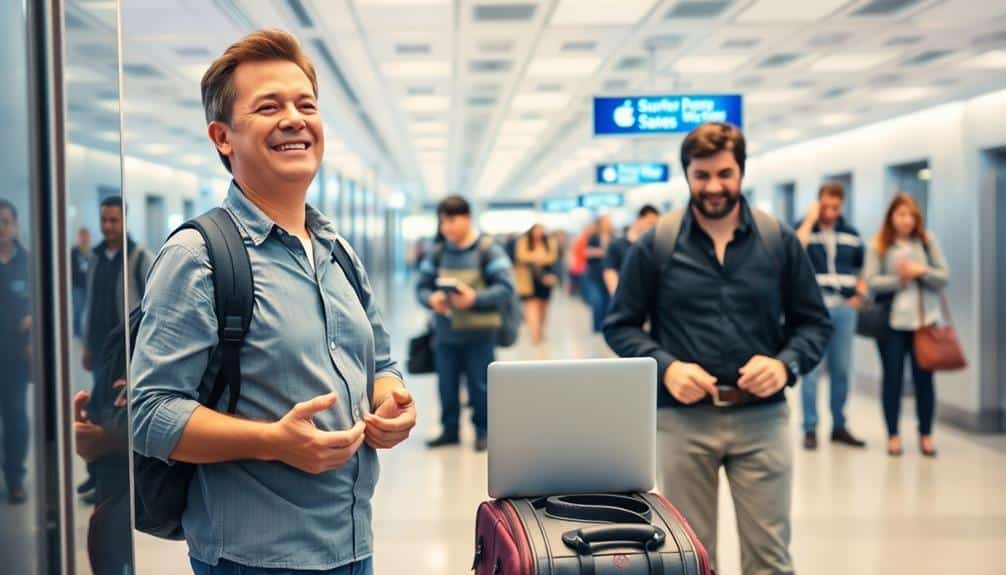
Patience is key when traversing airport security. Maintaining a calm demeanor and exhibiting polite behavior can substantially improve your experience and potentially expedite the process. Security personnel are trained to identify signs of nervousness or aggression, which may lead to additional screening.
To guarantee a smooth passage through security:
- Address officers respectfully, using "sir" or "ma'am" when appropriate
- Follow instructions promptly and without argument
- Avoid jokes or sarcasm, as they may be misinterpreted as threats
- Offer clear, concise answers to any questions posed by security staff
Frequently Asked Questions
Can I Bring My Emotional Support Animal Through Airport Security?
Like a shepherd guiding his flock, you can navigate airport security with your emotional support animal. You're allowed to bring your ESA through security checkpoints, but you'll need to follow specific guidelines. Inform the TSA officer about your animal, and be prepared to present documentation. Your ESA must be leashed or in a carrier, and you'll need to remove any accessories for screening. Remember, while ESAs are permitted, service animals receive more accommodations during travel.
How Do I Transport Medication That Exceeds the Liquid Limit?
To transport medication exceeding the liquid limit, you'll need to declare it at security. Bring a doctor's note or prescription label to verify its necessity. Pack your medications separately in a clear, resealable plastic bag for easy inspection. Inform TSA officers about your medication before screening begins. They may conduct additional testing but will allow medically necessary liquids in excess of 3.4 ounces. Remember, while these items are exempt from liquid restrictions, they're still subject to security screening.
Are There Special Procedures for Traveling With Musical Instruments?
When traveling with musical instruments, you'll need to follow specific procedures. Contact your airline in advance to understand their policies. For carry-on instruments, guarantee they fit within size limits or purchase an extra seat. Larger instruments may require special handling as checked baggage. Pack your instrument securely in a hard case, and consider purchasing additional insurance. At security, be prepared for extra screening, and always keep valuable instruments within sight. Some airports offer dedicated lanes for travelers with musical equipment.
What Should I Do if My ID Is Expired or Lost?
While you might think you're out of luck, don't panic if your ID is expired or lost. You should arrive at the airport early and inform TSA officers of your situation. They'll ask you to complete an identity verification process, which may include additional screening. You'll need to provide alternative forms of identification, such as credit cards, insurance cards, or utility bills. Remember, it's always best to keep your ID current and secure to avoid these complications.
How Early Should I Arrive at the Airport for International Flights?
For international flights, you should aim to arrive at the airport at least 3 hours before your scheduled departure time. This buffer allows for potential delays during check-in, security screening, and passport control. Factors such as the airport's size, time of day, and seasonal travel patterns can impact processing times. If you're traveling during peak periods or have special circumstances (e.g., traveling with pets or oversized luggage), consider arriving even earlier to guarantee a stress-free experience.
